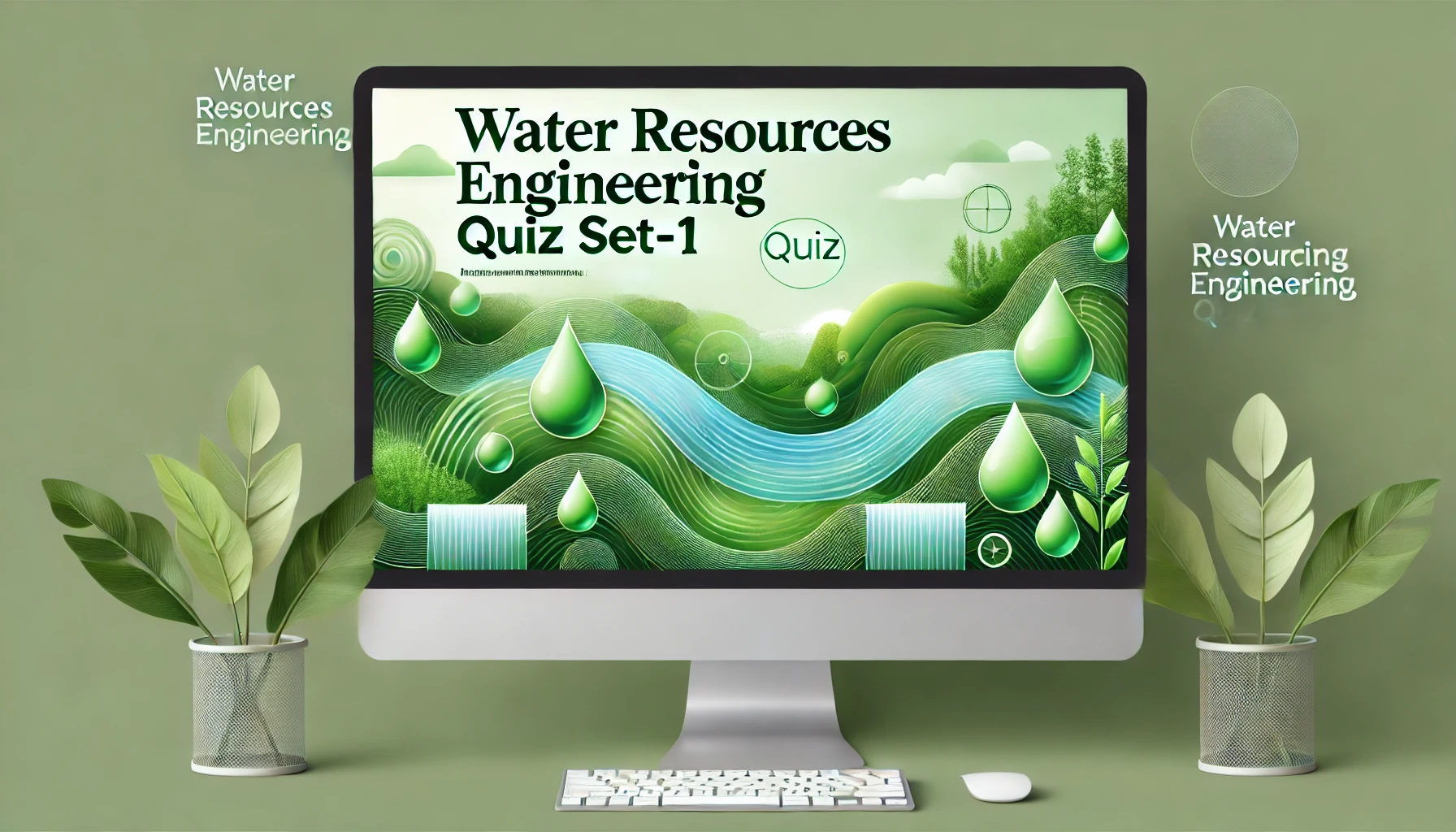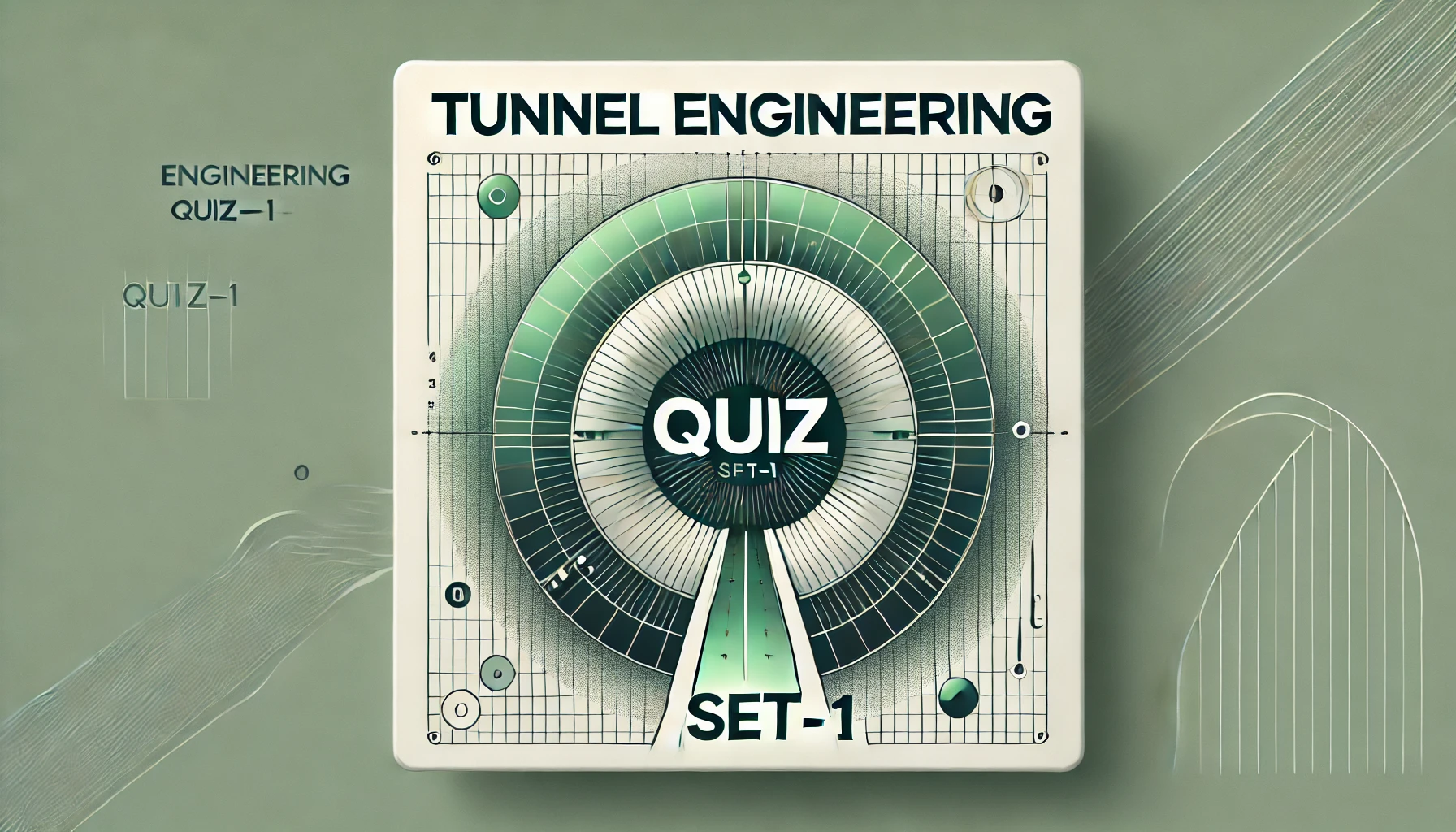Water Resources Engineering Quiz Set-1 [2025]
Welcome to “Water Resources Engineering Quiz Set-1 [2025]”! In this blog, we’ve curated 50+ thought-provoking multiple-choice questions covering the fundamental and advanced concepts of water resources engineering. “Water Resources Engineering Quiz Set-1 [2025]” is designed to help you refresh your basics, challenge your knowledge, and gain practical insights into the principles and techniques of managing water resources. Whether you’re a civil engineering student, a water resources professional, or preparing for competitive exams, this quiz is the perfect way to enhance your expertise in water resources engineering. Let’s dive into the “Water Resources Engineering Quiz Set-1 [2025]” and start exploring! Water Resources Engineering: Managing Our Most Vital Resource Water is the cornerstone of life on Earth, and managing it effectively is critical for human survival and environmental sustainability. Water resources engineering is the discipline dedicated to understanding, developing, and managing water systems to meet the needs of society while preserving the environment. It encompasses various aspects such as water supply, hydrology, irrigation, flood control, and wastewater management. See Also: Airport Engineering Quiz Set-1 The Scope of Water Resources Engineering Water resources engineering integrates principles from civil engineering, environmental science, and hydrology to address diverse challenges. Its primary focus areas include: Water Supply Systems: Ensuring a reliable and clean water supply for domestic, industrial, and agricultural use. Irrigation Engineering: Designing and managing systems to optimize water usage in agriculture. Flood Management: Developing strategies to predict, control, and mitigate flooding events. Hydropower: Harnessing the energy of water for electricity generation. Stormwater Management: Planning systems to manage and treat rainwater runoff. Wastewater Treatment: Treating and reusing wastewater to minimize environmental impact. Importance of Water Resources Engineering The importance of water resources engineering cannot be overstated. It addresses key global challenges, such as: Water Scarcity: Providing solutions to regions experiencing water shortages due to overuse or climate change. Sustainable Development: Balancing the needs of population growth with the conservation of ecosystems. Disaster Mitigation: Protecting communities from water-related hazards like floods and droughts. Energy Production: Supporting the development of renewable hydropower. See Also: Tunnel Engineering Quiz Set-1 Key Techniques in Water Resources Engineering Water resources engineers use a variety of techniques and technologies to design efficient systems, including: Hydrological Modeling: Simulating water flow and distribution to predict and manage resources. Remote Sensing and GIS: Mapping and analyzing geographical data for effective water management. Hydraulic Modeling: Studying the behavior of water in rivers, pipes, and other systems. Desalination: Converting seawater into potable water for regions with limited freshwater. Rainwater Harvesting: Capturing and storing rainwater for future use. Challenges in Water Resources Engineering Despite advancements, water resources engineering faces several challenges: Climate Change: Altering precipitation patterns and increasing the frequency of extreme weather events. Population Growth: Increasing demand for water resources in urban and rural areas. Pollution: Contaminating water sources with industrial, agricultural, and domestic waste. Aging Infrastructure: Requiring modernization and maintenance of water supply systems. Equitable Distribution: Ensuring fair access to water resources across different regions and communities. Real-World Applications of Water Resources Engineering Urban Water Supply Systems: Designing pipelines, treatment plants, and reservoirs for cities. Irrigation Networks: Supporting agricultural productivity with efficient water distribution. Flood Control Projects: Building levees, dams, and stormwater channels to protect communities. Hydropower Plants: Generating clean energy from rivers and reservoirs. Wetland Restoration: Rehabilitating ecosystems to improve water quality and biodiversity. The Future of Water Resources Engineering The future of water resources engineering will be shaped by innovation and sustainability. Key trends include: Smart Water Management: Utilizing IoT and AI to monitor and optimize water systems in real-time. Decentralized Systems: Implementing small-scale, local solutions for water treatment and supply. Renewable Energy Integration: Combining hydropower with solar and wind energy. Advanced Treatment Technologies: Developing methods like membrane bioreactors and nanotechnology for water purification. Water Recycling and Reuse: Enhancing systems to treat and reuse wastewater efficiently. How to Pursue a Career in Water Resources Engineering If you’re interested in contributing to sustainable water management, here’s how to start: Educational Requirements: Obtain a bachelor’s degree in civil or environmental engineering with a focus on water resources. Advanced degrees can help specialize in areas like hydrology or irrigation engineering. Skill Development: Develop expertise in hydrological modeling, data analysis, and project management. Knowledge of tools like HEC-RAS, SWMM, and GIS is essential. Certifications: Acquire credentials like Professional Engineer (PE) or Certified Floodplain Manager (CFM). Experience: Gain practical experience through internships, research projects, and fieldwork. See Also: Transportation Engineering Quiz Set-1 FAQs 1. What is water resources engineering? Water resources engineering is a field of civil engineering that focuses on the planning, development, and management of water systems to meet societal and environmental needs. 2. Why is water resources engineering important? It is essential for ensuring a reliable water supply, managing floods, supporting agriculture, generating hydropower, and protecting ecosystems. 3. What are the main areas of water resources engineering? Key areas include water supply systems, irrigation engineering, flood management, hydropower development, stormwater management, and wastewater treatment. 4. What skills are needed for a career in water resources engineering? Skills required include analytical thinking, proficiency in hydrological and hydraulic modeling, GIS expertise, and project management. 5. What challenges do water resources engineers face? Challenges include climate change, population growth, pollution, aging infrastructure, and equitable water distribution. 6. How does water resources engineering contribute to sustainability? By promoting efficient water use, recycling, renewable energy, and ecosystem restoration, it ensures long-term resource availability and environmental health. Water resources engineering is vital for shaping a sustainable future. By integrating technology, innovation, and environmental stewardship, it addresses the challenges of water management and supports the well-being of communities worldwide.


